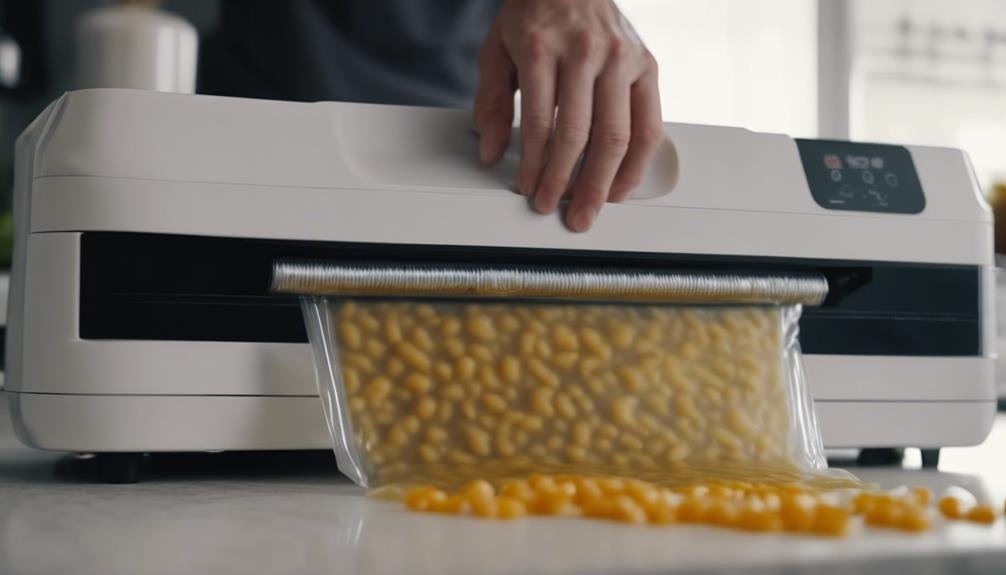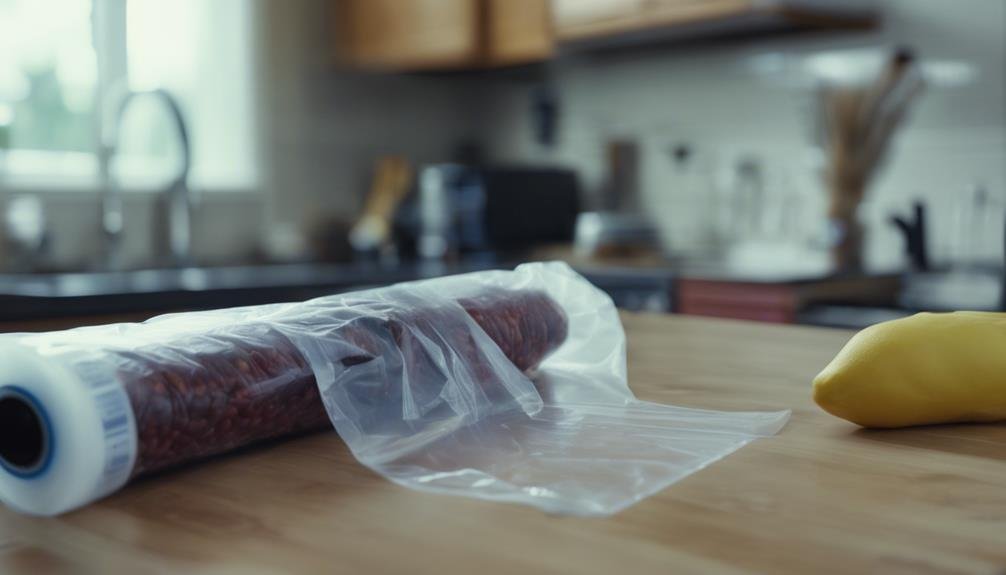Mastering vacuum sealing techniques is essential to preserve the quality and longevity of your frozen foods. Opt for BPA-free bags that are textured and have a thickness of at least 3 mil. Always ensure that your foods are cooled before sealing to prevent condensation and ensure a secure seal. Wipe the edges of the bags dry to prevent any liquid leaks, and consider placing a paper towel between packages containing liquids. To extend the shelf life and reduce freezer burn, use oxygen absorbers inside the bags. Don't forget to label the bags with the type of food and the date to keep your freezer organized. By following these steps, you can keep your frozen goods fresh and well-organized, optimizing your freezing process for best results.
Choosing the Right Bag
Selecting the appropriate bag is vital for efficient vacuum sealing and freezing. When choosing vacuum bags, prioritize those made from BPA-free materials to guarantee your food stays safe from harmful chemicals. Durability is essential, so opt for bags with a thickness of at least 3 mil. This thickness provides the necessary protection against punctures and freezer burn.
For effective air removal, select vacuum bags with a textured surface. This feature enhances the sealing process by allowing air to escape more easily, ensuring a tighter seal. If you prefer convenience, pre-cut bags can save you time, as they are ready to use straight out of the box. Alternatively, rolls of vacuum bags allow you to customize the size according to your specific needs, offering flexibility for different types of food items.
Consider using resealable vacuum bags for items you plan to access frequently. These bags allow you to open and seal them multiple times without compromising the vacuum seal's integrity. By carefully selecting the right vacuum bags, you'll guarantee your food stays fresh, safe, and well-preserved throughout its time in the freezer.
Cooling Food Before Sealing
Once you've chosen the right bag, it's important to cool your food before sealing to prevent condensation and guarantee a strong vacuum seal. Hot foods can produce steam inside the bag, which creates moisture that interferes with the vacuum process. This condensation can compromise the seal, reducing the efficiency of air removal and potentially shortening the shelf life of your food.
Start by letting hot foods reach room temperature or use an ice bath to speed up the cooling process. This step is essential for maintaining the texture and quality of the food when it's eventually thawed and consumed. Rapid cooling prevents moisture accumulation, which ensures that the vacuum pressure remains optimal and that the seal is airtight.
If you skip the cooling step, you risk trapping steam inside the bag, which can create a barrier to effective air removal. Properly cooled food items will not only help you achieve a better vacuum seal but also extend the longevity of your stored items. By taking the time to cool your food before sealing, you're making sure your efforts in vacuum sealing pay off in the long run.
Preventing Liquid Leaks

To prevent liquid leaks when vacuum sealing, make sure to wipe the edges of the bag dry before sealing. This essential step guarantees a proper seal, which is vital to avoid spills and maintain the integrity of your vacuum-sealed package. When dealing with liquids, vacuum sealing helps preserve freshness and extend the shelf life of your items.
Using a vacuum sealer like a FoodSaver, you can effectively seal liquids without needing specialized equipment. After placing your liquid in the bag, use paper towels to thoroughly dry the edges. This prevents spills during the sealing process and helps achieve a tighter seal. Additionally, placing a paper towel between liquid packages keeps them from sticking together, making it easier to stack them in the freezer.
For ideal freezer space, vacuum sealing liquids in flat, uniform packages is key. This not only saves space but also makes it simpler to organize your freezer. Flat packages stack neatly and can be stored more efficiently. By following these steps, you can enjoy the benefits of vacuum sealing while preventing liquid leaks and maximizing your freezer space.
Using Oxygen Absorbers
Utilizing oxygen absorbers in vacuum-sealed bags effectively extends the shelf life of your frozen foods. By incorporating these tiny packets, you can eliminate any remaining oxygen inside the vacuum sealed bags. This not only helps in maintaining food quality but also reduces the risk of freezer burn. When you use vacuum sealers along with oxygen absorbers, you guarantee that your food storage is more efficient and your preservation efforts are maximized.
Oxygen absorbers are designed to remove residual oxygen, preventing oxidation that can degrade the food over time. This means your frozen foods will retain their freshness and taste for much longer. When you're serious about food storage, combining vacuum sealers with oxygen absorbers is a game-changer. Properly sealed vacuum bags with these absorbers can keep your food in excellent condition, greatly extending its shelf life.
Labeling and Dating Bags

Labeling and dating your vacuum-sealed bags is essential for keeping track of the freshness and ensuring you use older items first. When you label each bag with the food type and date, you prevent confusion and waste by easily identifying the contents. This step is vital for maintaining organization in your freezer and avoiding food spoilage.
Clear labeling helps with meal planning and inventory management, allowing you to quickly find what you need. Use a permanent marker or freezer-safe labels to guarantee the information remains visible and intact during storage. Here's a simple table to guide you on what to include when labeling:
| Label | Details |
|---|---|
| Food Type | Describe the contents |
| Date | When it was vacuum sealed |
| Use By Date | Recommended consumption |
| Quantity | Amount in the bag |
| Special Notes | Any additional info |
Proper labeling ensures that you consume food in the order it was stored, preserving maximum freshness. By keeping a well-organized freezer, you can minimize food spoilage and make meal prep more efficient. Don't underestimate the power of a well-labeled vacuum-sealed bag; it's a small step that leads to big benefits in kitchen organization.
Conclusion
So, you've got the essentials: the right bag, cooled food, leak prevention, oxygen absorbers, and clear labeling. Think of your vacuum sealer as a superhero cape for your food, preserving its freshness and flavor. By following these techniques, you'll maximize your freezer space and minimize waste. You're now ready to freeze with confidence. Happy sealing!
